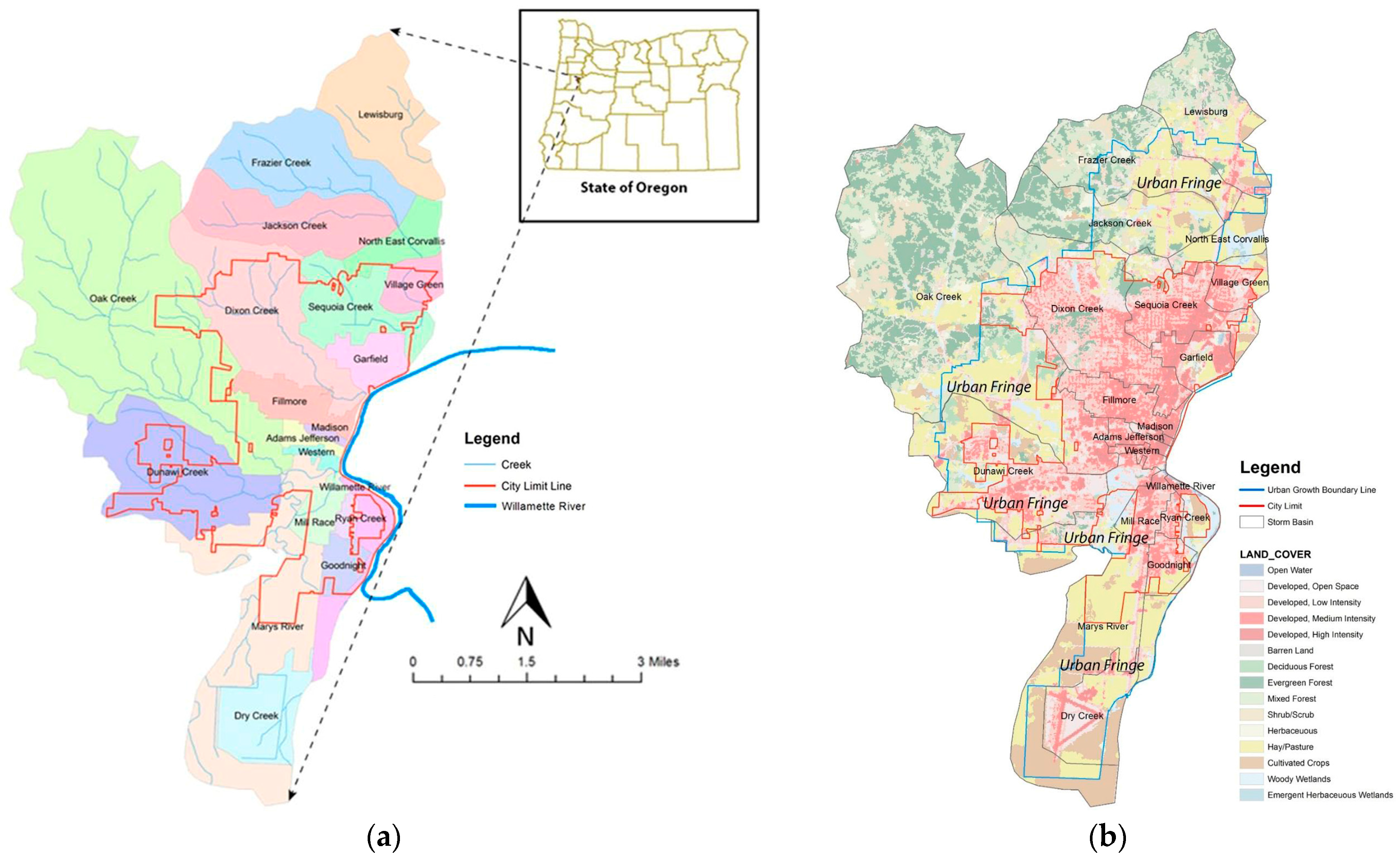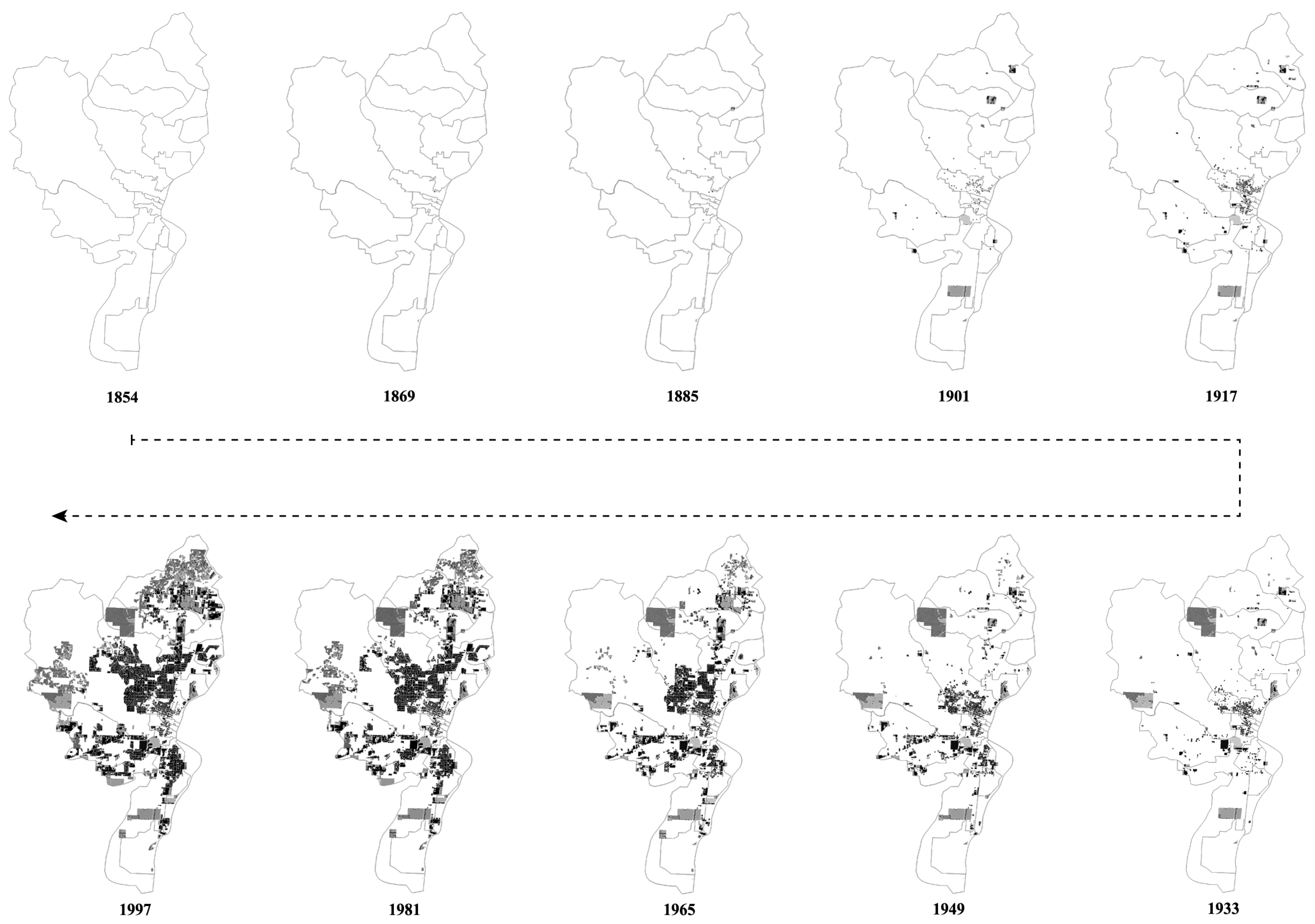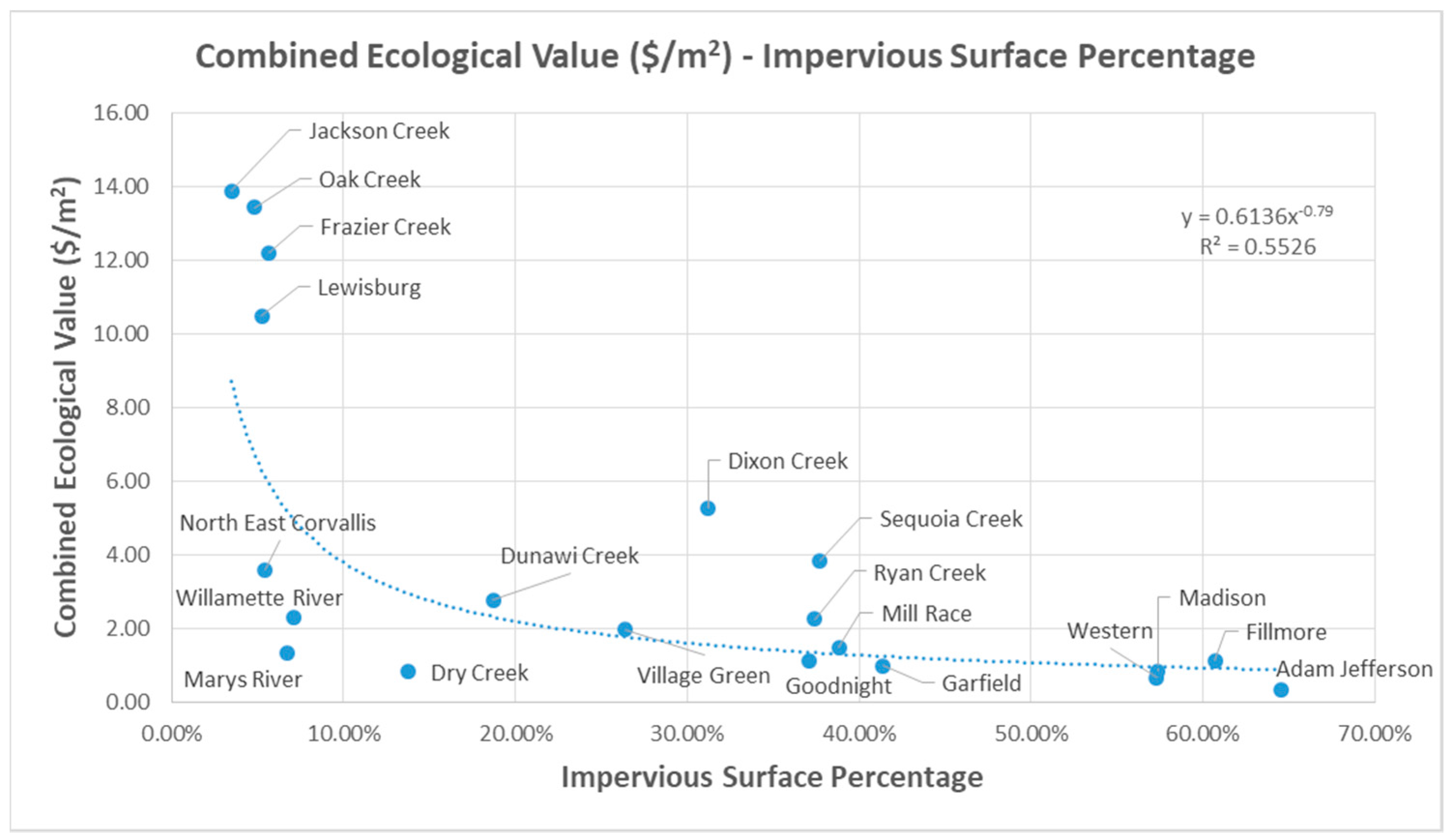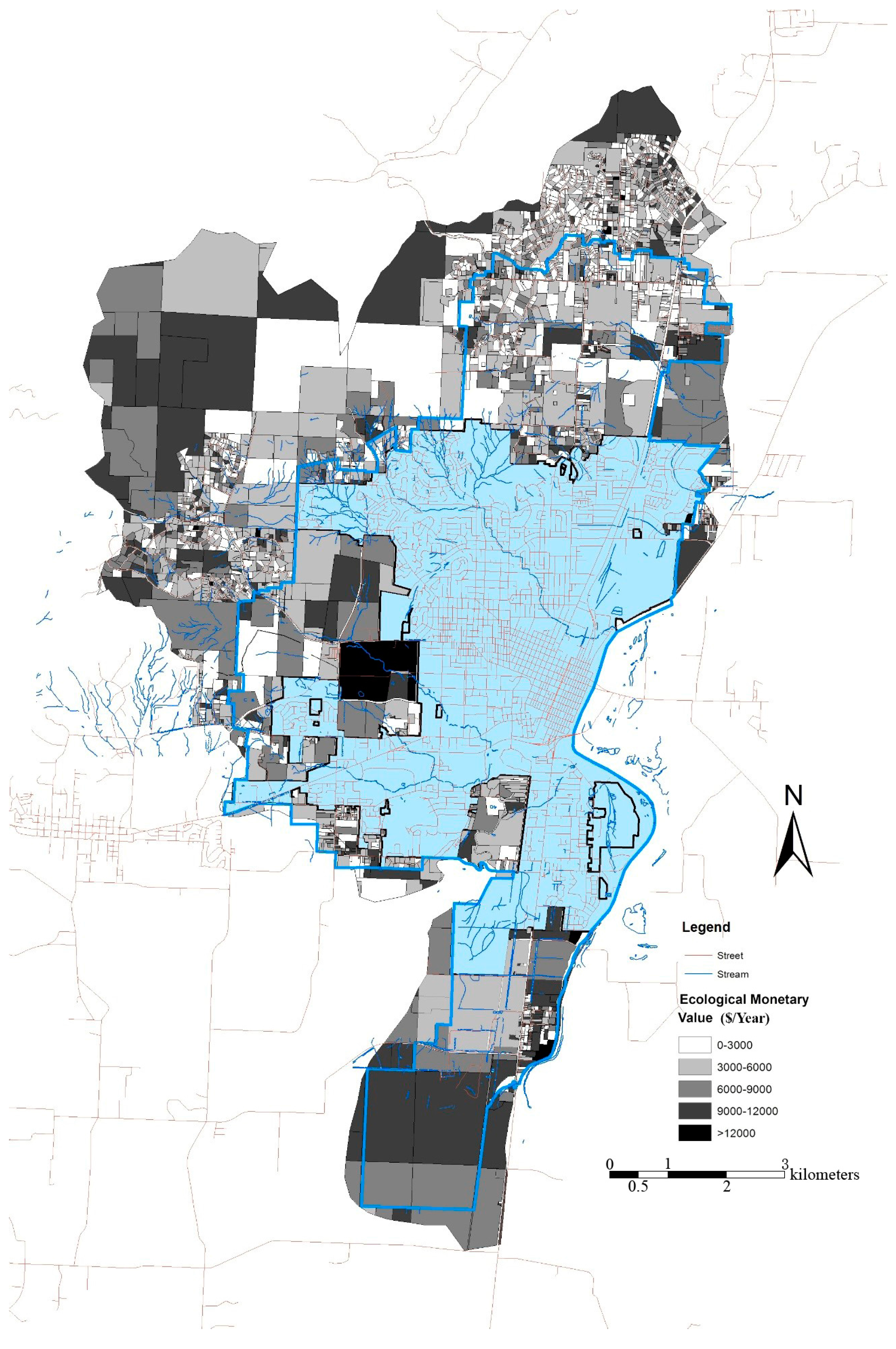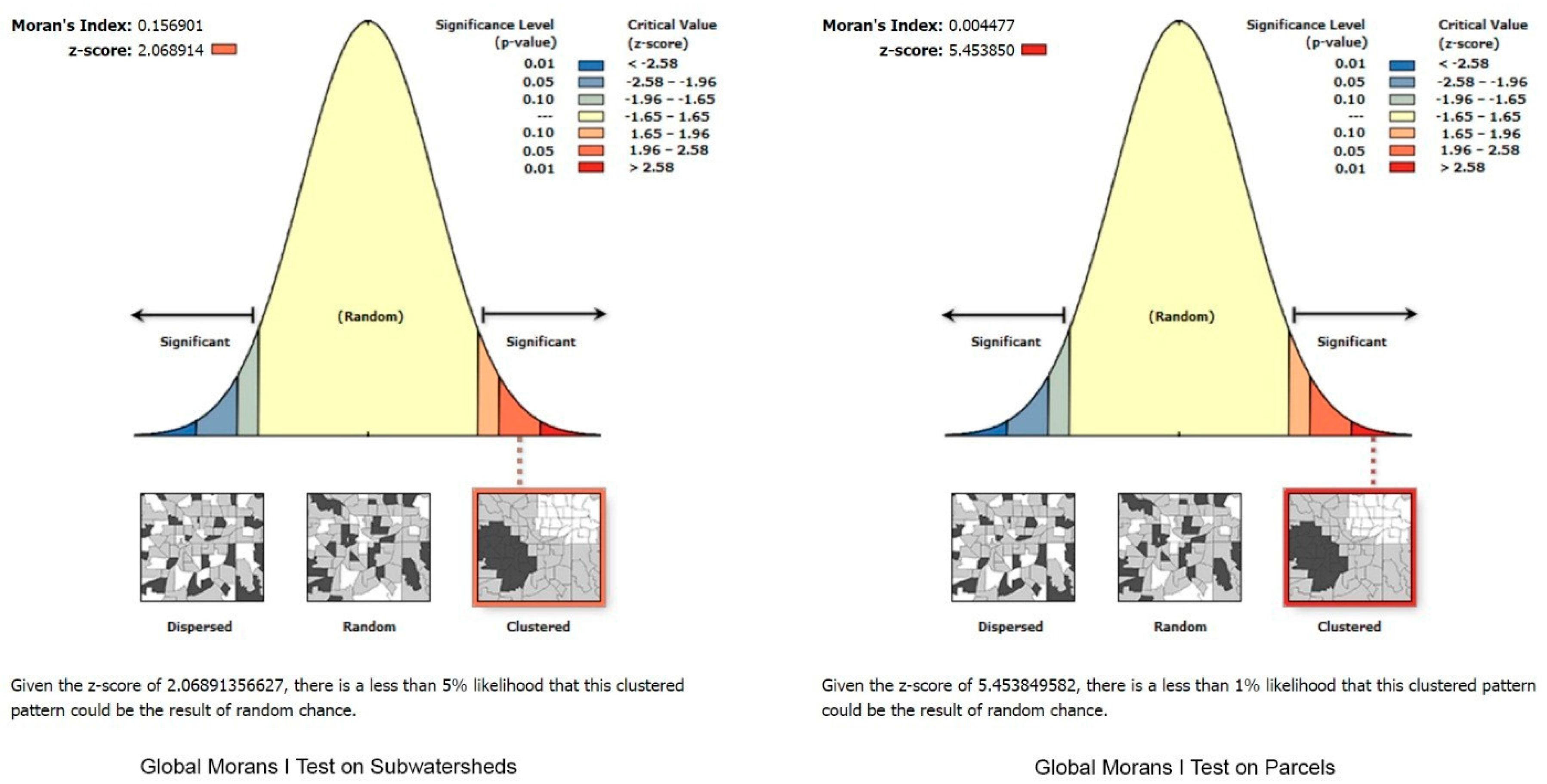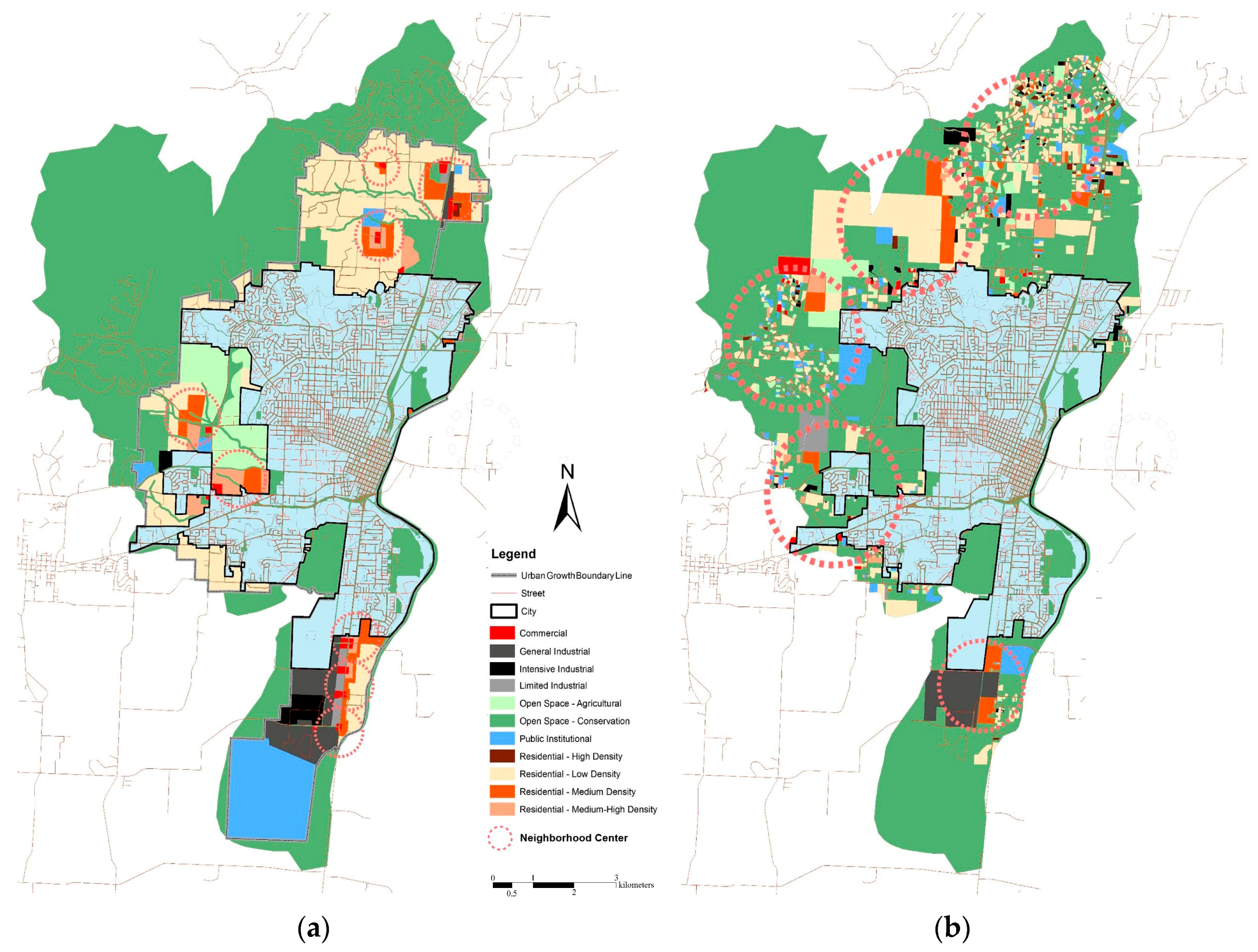3.1. Current Comprehensive Plan 1998–2020 Evaluation
The urbanization’s ecological impacts through exporting nonpoint storm water pollution and losing carbon storage from 1998 to 2020 in the city of Corvallis were summarized in
Table 2. Under the Corvallis Comprehensive Plan, the city is modelled to discharge 52% more nitrogen pollution and 159% more phosphorous pollution into storm water, and losing 11% carbon storage in the entire drainage basin due to the urbanization from 1998 to 2020. Within the City Limit, nitrogen and phosphorus pollution exports rise by 44% and 157% respectively, and the carbon storage drops by 9%. The high percentage of nitrogen and phosphorus export is consistent with previous research finding that Willamette Basin is facing increasing risk of water contamination due to nitrogen input and phosphorus input [
47,
48]. All of these three results are less than the general impacts across the entire drainage basin. This could be explained by the fact that there is less available lands for new urban development within the City Limit and the urbanization rate tends to be slower from 1998 to 2020. The storm water pollution export and carbon storage stay almost the same outside the Urban Growth Boundary because of few land cover alteration in these lands. However, in the Urban Fringe area, storm water nitrogen and phosphorus export are modelled to be increased by more than 80% and 200%, respectively, and carbon storage is predicted to lose by 60% in 2020. All of these three outcomes are much higher than the general impacts across the entire drainage basin and the reason could be the fact that compared with the area within the City Limit, the ongoing urbanization process in the urban-rural fringe is more likely to cause the corresponding environment and biodiversity degradation due to its sensitivity to urbanization interruptions [
49].
Based on the Corvallis Comprehensive Plan 1998–2020, 35 km
2 land are planned to be urbanized from 1998 to 2020 (Average Urbanization Rate: 35 km
2/22 year = 1.6 km
2/year) [
23], this is predicted to result in 3312 kg more nonpoint nitrogen pollution discharge into the urban storm water 1260 kg more nonpoint phosphorous pollution discharge into the urban storm water, and 237,719 Mg carbon storage loss in the terrestrial land. We compared the predicted urbanization’s ecological impact from 1998 to 2020 with it through the city’s historical urbanization process from 1854 to 1997 shown in
Figure 2, and the results were listed in
Table 3. It is evident that the urbanization rate from 1998 to 2020 is planned to be higher than any previous period in the city’s history. The carbon storage loss rate is projected to be 309 Mg/km
2 per year that is slower than the historical average rate (1247 Mg/km
2 per year). However, one square kilometer of land developed under urbanization is modelled to export into storm water 4.3 kg nonpoint nitrogen pollution per year and 1.6 kg nonpoint phosphorus pollution per year, both of which are higher than the averages in the city’s history (3.8 kg/km
2 per year for nitrogen pollution export and 0.49 kg/km
2 per year for phosphorus pollution export). Based on this analysis, the planned Corvallis urban area in 2020 provides more ecosystem service in storing carbon to regulate climate, but the nonpoint storm water pollution is still an issue in 2020 and more green infrastructures are suggested to be implemented in the Comprehensive Plan to purify storm water in the urbanized area. It indicates that there exists ecosystem service trade-offs under the Comprehensive Plan 1998–2020 and the plan performs effectively in enhancing the region’s capacity of storing carbon, but it does not restrain the urbanization’s trend in discharging more nonpoint nitrogen and phosphorus pollution in urban storm water.
Different with previous studies that evaluated the performance of planning strategies and policies through comparing the situation across cities in the same period [
50,
51], this study analyzed the situation of different historical periods in the same city to rule out the comparison and contrast interfere due to uncontrolled conditional variance from different cities. The results suggest that planning policies and strategies may unintentionally contribute to environmental degradation in one way or another and planners should weigh the ecosystem service trade-offs in making the comprehensive spatial planning.
3.2. Ecological Value Distribution
The ecosystem services provided by the entire drainage basin in purifying storm water nitrogen, purifying storm water phosphorus and storing carbon in 1998 were quantified in InVEST. Based on the quantification result and Equation (1), the ecological value was calculated and summarized by each sub-basin in GIS (
Table 4). The combined ecological value of the entire drainage basin in purifying storm water and storing carbon is worth up to
$9 million per year. The sub-basins within the top quartile are Dixon Creek, Lewisburg, Frazier Creek, Oak Creek and Jackson Creek. These are the undeveloped sub-basins located along the northwest edge of the drainage basin (
Figure 1a). The sub-basins in the bottom quartile are Fillmore, Garfield, Madison, Western and Adams Jefferson. These five sub-basins intersect with the city’s Downtown area with higher percentage of impervious surface (
Figure 1b). This coincides with the finding in previous studies that ecosystem services were offered by the green space with a linear-gradient changing from the urban center to the periphery [
52]. The results suggest that the most urbanized watershed has the greatest impact on ecosystem service values. Some basins are smaller in size, but they have higher percentage of impervious pavement, especially within the urban center, and their performance improvements in providing ecosystem services may be larger if low impact development strategies are implemented, such as green roof, pervious pavement and rain garden [
53].
Taking a close-up examination, a strong power regression relationship with the correlation coefficient as 0.74 was established between the impervious surface percentage and the combined ecological value per unit (
Figure 4), which confirms that the area with higher impervious surface percentage has more influences on the ecological value estimated on the local level in Corvallis. This also implies that converting the ecosystem service into the combined economic ecological value could be a way to deal with ecosystem services trade-offs [
54], and local land owners could lessen urbanization’s ecological impacts by controlling the impervious percentage within their land, even though they may not change environment degradation drivers on the regional scale [
55].
Due to the fact that most urbanization development is planned outside the City Limit from 1998 to 2020 [
23], the combined ecological value outside the City Limit was mapped on the parcel level in GIS (
Figure 5). Through the Global Moran’s I test for the combined ecological value distribution, the outcome shows that the z-scores on both the sub-basin level and the parcel level are higher than 1.960, which means that the spatial autocorrelation relationship exists on both local levels (
Figure 6). This could be explained by the homogeneity of environmental characteristics across closer spatial patterns [
56]. The result shows that the combined ecological value is distributed with assemblage patterns at local scales, which indicates that making the land use plan according to the ecological value distribution patterns is feasible. The z-score on the parcel level is higher than it on the sub-basin level, which means the distribution assemblage pattern on the parcel level is clearer than it is on the sub-basin level. This suggests to probe the land use planning with the goal to preserve more ecological values using the parcel land as the unit of analysis. Therefore the combined ecological value mapping on the parcel level (
Figure 5) was utilized to identify priority lands for future land uses to conserve more ecological values in the process of urbanization.
3.3. Priority Lands Identification for Land Uses
According to Corvallis Comprehensive Plan 1998–2020, 31 km
2 natural land is planned to be urbanized into 11 urban land use classes outside the City Limit to meet the city’s future development demands. This study set up the assumption that the same land use area is developed with the same percentage of impervious surface as it was in 1998.
Table 5 summarizes the land use classes to develop, the demanded size and the percentage of impervious surface in each land use category. We identified priority lands for land uses pattern delineation with the goal to accommodate these 11 land use classes as planned to develop and conserve most combined ecological value. The priority lands were identified for each land use zoning grounded on the environmental planning principle that the lands with lower ecological value should be zoned for the land use class impacting more on the ecological value and the lands of higher ecological value should be prevented from urbanization. As discussed in previous sections, the power correlation relationship confirms that the land use class with high impervious surface percentage results in less combined ecological value left in Corvallis. Based on the ecological value map (
Figure 5), the Spatial Matrix M described in
Figure 3, Equation (2), Equation (3) and the environmental planning principle, priority parcels for each future land use class was zoned in GIS. Corvallis is predicted to need 438,296 m
2 of land urbanized for the commercial use and the commercial land use category has the highest percentage of impervious surface. Therefore, the first group of parcels with the accumulating size over 438,296 m
2 in the combined ecological value low to high ranking matrix is zoned as commercial land use. Following the order to be zoned (
Table 5) and the same step, all the other ten land use patterns are delineated on the map (
Figure 7).
As the result, in the proposed land use plan, all parcels with the combined ecological value higher than
$6000 per year and more than half of parcels with the combined ecological value between
$3000 to
$6000 per year are preserved from urbanization (
Table 6). In comparison with Corvallis Comprehensive Plan 1988–2020 featured with compact development hubs close to the City Limit, the new land uses plan proposes five bigger mixed-use urban centers spreading outside the City Limit. Similar with the Comprehensive Plan, industrial areas are mainly planned next to the south edge of the City Limit. But differently, commercial areas, various residential types, public institutions are spreading outside the City Limit across the north and west part of the drainage basin.
We also quantified the ecosystem services provided by the conserved parcels under the Corvallis Comprehensive Plan 1988–2020 and the proposed land uses plan. Previous studies claim that compact development leads to less ecological impacts than the spreading development due to the understanding that compact development restrains urbanization within certain area and conserves more natural resources [
57,
58,
59], but our results show that the entire drainage basin under the proposed land use plan featured by spreading mixed-use developments stores nearly 20% more carbon and retains over 100% more storm water nonpoint nitrogen, 270% more storm water nonpoint phosphorus than it under the Comprehensive Plan featured by compact development close the City Limit (
Table 7). This could be explained by the finding that compact developments have more severe impacts on the local biodiversity even though it is restrained in certain areas and conserve more natural lands untouched [
60].
It is undoubtable that spreading mixed-use developments in the proposed land use plan would require more investment in urban infrastructures construction (e.g., expansion of power facilities, drainage systems and streets) [
61]. Also, the spreading urban development far away from the urban center would disturb wildlife habitat and result in biodiversity loss [
62], and generate more commuting CO
2 emissions as well [
63]. Therefore, the land use plan generated in this study could not have been the most practical urbanization plan for the city to implement at this stage. However, as indicated in previous studies, the preserved natural lands distributing among the spreading urbanization play the role of stepping stones to strengthen the regional biodiversity and provide residents more recreational accessibilities to nature [
64]. Moreover, the spread of urban development appears to be more able to reduce traffic congestion than the compact development [
65]. Preserving the stepping stone natural lands to enhance landscape connectivity and developing public transportation to reduce commuting travel miles might complement the proposed spreading mixed-use developments.
